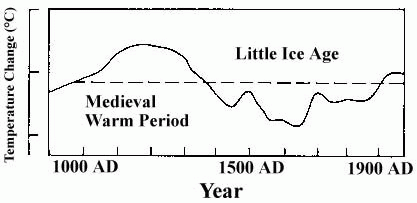Show Me the Beef
I have been arguing with the global warming warriors for some time now. Thus far I think that Newton's Third Law - for every action there is an equal and opposite reaction - is proving to be true. I have convinced them of nothing, nor has my opinion been altered one iota. I even tried to quit the debate, but every time I try to get out, they pull me right back in... Don't forget the canolis.
I don't like to give up, however, and every time I read about another natural disaster being blamed on the one degree Fahrenheit increase in global temperature over the last 120 years, I'm convinved that a sane voice is needed more than ever.
Thus, in a series of three blog pieces, I will attempt to make the case about the reality of global warming, to say what not to do about it under any circumstances (most of what is being pushed down our throats), and to propose some reasonable approaches to influencing the climate.
I'll begin with the data. The first and most important fact is that the global climate is continuously changing and has been for over four billion years. On an archeological time scale, the Earth started out VERY HOT (say 80 deg. C or 176 deg. F) and was that way for a billion years or so, before slowly cooling to 40 deg. C about 2 billion years ago and 15 deg. C today. But during that time there have been long periods of EXTREME COLD (mega Ice Ages) where the Earth nearly froze completely around 2.3 billion years ago and again around 700, 400 and 285 million years ago. Around 60 – 70 million years ago the whole Earth was a tropical paradise and the dinosours roamed. Sea levels were perhaps a hundred feet higher than now.
Over the last 2 million years the Earth has settled into a temperature oscillation of Ice Ages and warm interglacial periods on a hundred-thousand-year time scale. The reason for these cycles is well known to be the Earth's orbit around the Sun that changes from nearly circular to a pronounced elipse with that period.
The following figure taken from the UN Intergovernmental Panel on Climate Change (IPCC) shows the glacial periods for the last 450 thousand years punctuated by interglacial warm period about 420,000 years ago, then again 325,000 and 240,00 and 120,000 and the one we are living in (the Holocene) starting around 12,000 years ago. This variation is exactly what we expect from the Earth's orbital motion. The other more rapid oscillations are caused by variation of the tilt of the Earth's axis on a 41,000 year cycle and the Earth's precession about its axis on a 22,000 year cycle.
Each factor influences how much sunlight strikes the Earth and changes the global temperature. It's all just basic physics. Yet the top figure (below) from the IPCC study shows that the Carbon Dioxide (CO2) also exhibits the 100,000 year cycles, in phase with the interglacials. Interesting coincidence, or perhaps the warmer Earth (caused by the Sun) generates more CO2, not the other way around?

The last eight interglacial periods have each lasted for about half of the 22,000 year precessional cycle, or 11,000 years. On that basis our current warm period is about due to end. But since the orbital eccentricity is near its minimum, the Holocene warm period may last for another thousand years or so. The interglacial around 400,000 years ago lasted longer than usual for that same reason. But there is no doubt, the Ice Age will return, if not in 100 years then in 500 or 1000. Count on it.
Of course the end game is fire. When the Sun enters the red giant phase in, perhaps, 4 billion years the oceans will evaporate and the Earth will eventually burn to a crisp. There is not a darn thing we can do about it. What you can say fo sure about the Earth's environment is that it is continuously changing, a lot, and there is little we can do about it.
Now that we have looked at the big picture, what about the last 1000 years? From ice cores we have a reasonably accurate understanding of the last milenia. A graph taken from the 1990 IPCC assessment is shown here.

Note that from 1000 to about 1350 there was a Medieval Warm Period when sea ice melted and the Vikings inhabited Greenland. It was 2 deg. C warmer then than it is now (and burning fossil fuels did not cause it). The warm period was followed by a Little Ice Age from 1400 until nearly 1900 when glaciers grew, the sea ice choked the North Atlantic and the villages in Greenland died out for lack of food. Only in the last 100 years has the temperature climbed back to the levels of 800 years ago, a natural warming following a Little Ice Age within a 12,000 year interglacial warm period.
Even during the last century the temperature did not increase continuously as there was a period between 1940 and 1970 when the global temperature decreased, even as the CO2 levels increased. Clearly there was other natural stuff going on. The Earth's temperature controller is a very complex and little understood multiple feedback system, more resembling chaos than the nice systems that physicists like to study.


2 Comments:
Uh, oh... Inconvenient truth from Bill. I'll have to turn up the font:
NO WMD!
NO WMD!
NO WMD!
Go Bill. Please tell how the hockey stick model responds to its inputs. I read (junkscience.com) that it's a hockey stick irrespectice of changes in its inputs, and that nobody has been allowed to se its innards.
PV Dan
Thanks Bill. Great post.
Post a Comment
Subscribe to Post Comments [Atom]
<< Home